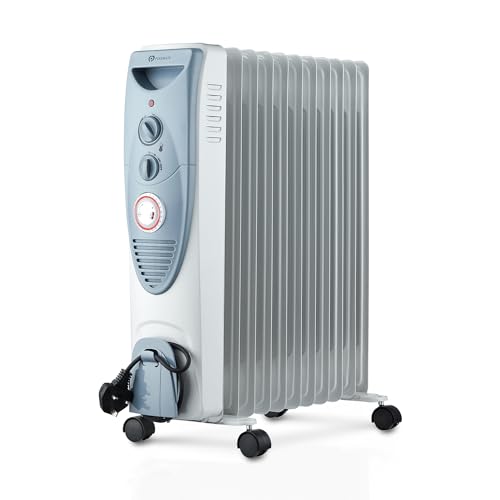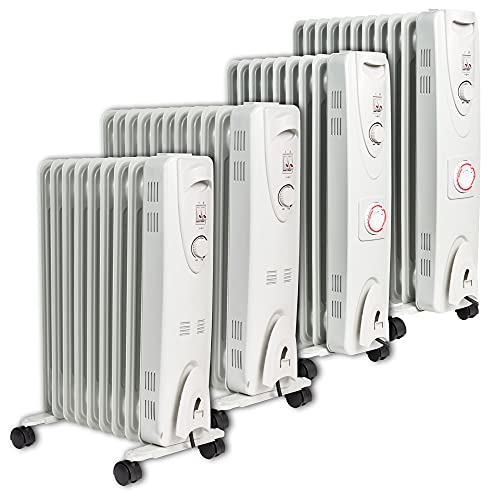Who Is Oil Filled Radiator Oil And Why You Should Care
페이지 정보
작성자 Marco 작성일24-09-11 04:59 조회5회 댓글0건본문
 Why Choose an Oil Filled Radiator?
Why Choose an Oil Filled Radiator?Oil-filled radiators provide a lot of warmth. They offer consistent heat, don't lose their heat too quickly, and are simple to maintain.
They can be installed anywhere unlike central heating systems which depend on interconnected pipes. They are easy to operate and come in both portable oil filled radiator [click the up coming site] and fixed options.
Safety
Oil-filled radiators differ from regular electric heaters because they contain a thermal oil to create the warmth. They also take time to cool down and warm down, meaning they're a good choice for rooms that are frequently used, not on a temporary basis. This also makes them better for those who have well-insulated homes and are concerned about energy efficiency.
While the radiator's oil could appear to be a risky component to store in an electric heater, these are designed with your safety in mind. These units are tightly-fitted and fully sealed, and do not require the use of a fan. They're typically built as flat panels that have wheels or carrying handles for easy repositioning. The only danger with an oil-filled radiator is if it's not properly handled or if it is used outside of the manufacturer's guidelines.
The majority of people who are brand new to these types of heaters aren't certain how safe they really are. Some people worry that the oil has to be replaced regularly. However, this is simply not the case, as the diathermic oil contained in an oil-filled radiator functions as a thermal reservoir and not as a fuel that can be ignited. It's also important to note that the oil itself is not fire-proof, which means it will not ignite when exposed to high temperatures.
Oil filled radiators are generally safer than other types of electric heaters. This is particularly true for portable versions which can be moved around easily. They're typically powered by electricity from the home and are connected to a wall mountable oil filled radiator outlet, therefore they can be used anywhere that you require heat. However, it's still recommended to avoid using these radiators that have extension leads since this could result in an explosion.
With the proper design, an oil-filled radiator can be a fantastic addition to any room. These appliances are a great way to keep your home warm according to your needs. There are a range of models, from the classic to the modern. Many are even compatible with WiFi control to provide maximum convenience.
Stability
The radiators that are filled with oil don't cool down instantly like a regular gas central heating system, which means that they stay warmer for longer than other types of electric heaters. The diathermic oils that are used in them have two characteristics that make them a great heat storage system - they have a very specific heat capacity and the low boiling point. It will absorb a large amount of heat, and keep it even after the heater has been shut off.
One of the most common misconceptions about oil room heaters is that the oils inside the appliance need to be replaced regularly however this isn't the case. oil filled radiator oil is used to serve as a thermal reserve and does not burn during the heating process. Since they are sealed units, the oil is unlikely to require replacement. If the oil needs to be filled up it should, however, be done by an expert.
Since they don't have moving components, and are built with safety features such as anti-tips and auto shut off technology, oil filled radiators are extremely safe to use in homes with pets or children. They're also virtually silent when in operation, which makes them a perfect choice for bedrooms and media rooms that need to keep noise levels at the minimum.
In terms of maintenance, oil filled radiators are very easy to maintain and can be easily cleaned down with a damp sponge. If they aren't covered in dust, they could be left in a state of disrepair for long periods of time. It's an ideal idea to clean them every now and then to keep grime and dirt from building up on the surface of the radiator.
Installing most oil-filled radiators requires a professional electrician who will hardwire them into an insulated spur, and then connect them to electricity. This is a simple task that won't cost you a fortune, and will ensure your electric radiator is safe for use.
Efficiency
Contrary to panel heaters and dry thermal radiators, that use electricity to heat up and cool down, oil-filled radiators retain their heat for up to an hour after it has stopped consuming energy. They can heat the room more slowly and evenly, giving you more time to be comfortable. It also helps lower costs for energy since they only use electricity for short intervals of time.
Modern radiators with oil-filled fuel are constructed with digital thermostats to be extremely efficient. This means that they can maintain your desired temperature with utmost accuracy, leaving only a tiny space for fluctuation. As a result, they only need to be turned on for a short period of time every hour to ensure your home is at a perfect temperature.
Radiators that are filled with oil, which utilize diathermic oil, heat the room evenly, eliminating cold spots. This increases comfort and saves on energy bills since you won't need to constantly switch your heating up and down to accommodate uneven heat distribution.
Oil-filled radiators are offered in fixed and portable options to meet your needs. Portable oil filled radiators are ideal for instant warmth and fixed models offer superior heat retention to save you money on your energy bills. They come in a range of finishes, styles and sizes to suit your home and interior design.
The additional benefit of using an oil-filled radiator is that it doesn't need to be refilled, unlike other types of electric heaters. Unless the radiator is damaged, it will never need replacing and you can anticipate it to last for many years without issue.
All of our oil-filled radiators are fitted with a built-in energy-saving thermostat and innovative programming features like precision thermostats, 24/7 scheduling and open window detection adaptive start and WiFi control. When combined, these features make them more efficient than gas central heating and help to lower your energy bills.
Less Electricity
Additionally, they consume far less electricity than central heating systems (due to the loss of heat energy through pipes and ducts), black oil filled radiator filled radiators oil filled are also 100 100% efficient at the point of use. Every watt of electricity converted into usable heat, so there is no waste. They also make a great investment for heating homes all through the year, thanks to their ability to retain heat and digital thermostats.
Electric oil radiators are easy to use. Inside is a heating element, composed of a metal resistive wire. When the radiator is switched on, the heating elements zap electrons in oil and friction results. The thermal fluid then spreads all over the body of the radiator, and the warmth is then dispersed throughout the room through natural convection.
Remember that oil-filled radiators tend to take longer to heat up and cool down than other kinds. This is due to the fact that the oil filled radiators with thermostat requires time to reach all the places within the radiator body. But, this slow cooling helps to reduce energy consumption.
In addition to this oil radiators release about a third of their heat through radiation. This type of heating is used to heat surfaces, objects, and people, rather than the air volume.
One thing to bear in mind is that it's important to not fill a radiator with oil unless you are a professional. This is a risky job and should only ever be done by an engineer. The vast majority of manufacturers fill their equipment with water only to a certain amount and leave a gap at the top out of safety.
 It is also important to estimate how much the oil-filled radiators consume in electricity each day or hourly and keep an eye on your bill. This can be done by determining the wattage of your radiator, which is usually displayed on the label, and then multiplying this by the number of hours it is utilized on a daily or hourly basis to determine an estimate of its electricity consumption in kilowatt-hours (kWh). This will allow you to better manage your energy consumption.
It is also important to estimate how much the oil-filled radiators consume in electricity each day or hourly and keep an eye on your bill. This can be done by determining the wattage of your radiator, which is usually displayed on the label, and then multiplying this by the number of hours it is utilized on a daily or hourly basis to determine an estimate of its electricity consumption in kilowatt-hours (kWh). This will allow you to better manage your energy consumption.댓글목록
등록된 댓글이 없습니다.




